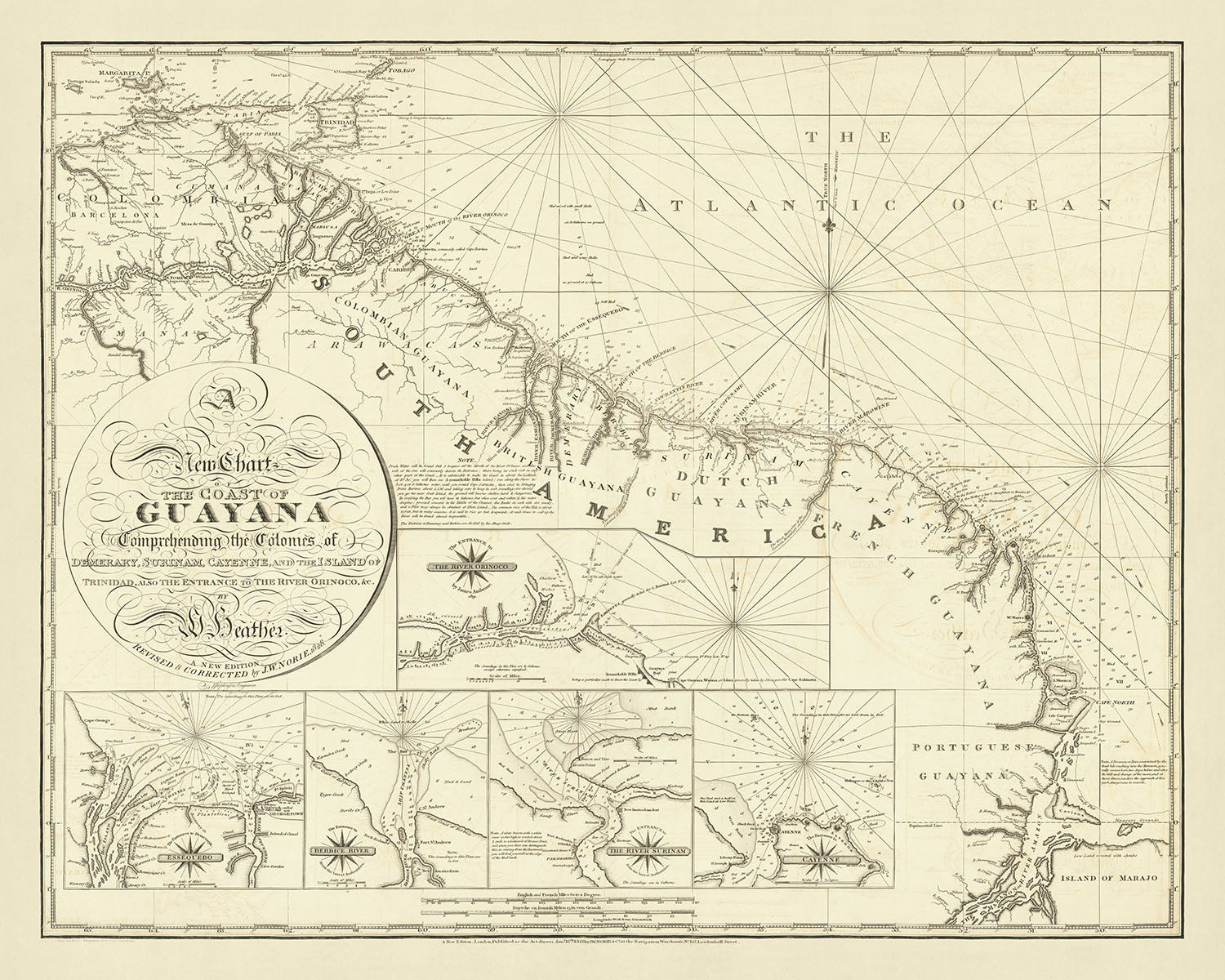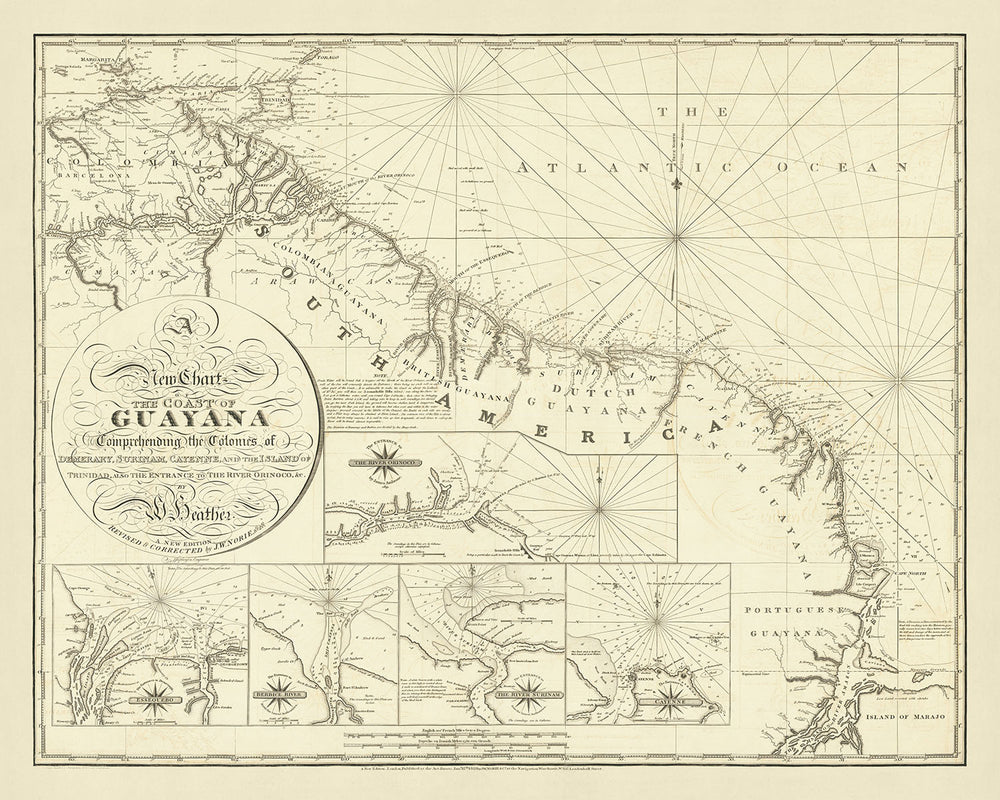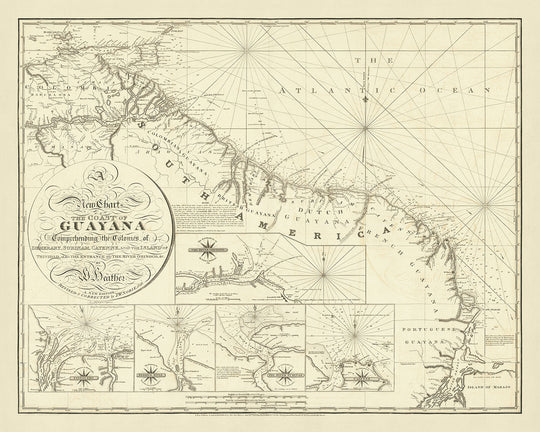- Handmade locally. No import duty or tax
- FREE worldwide delivery
- Love it or your money back (90 days)
- Questions? WhatsApp me any time
Own a piece of history
5,000+ 5 star reviews


Immerse yourself in the rich history of the early 19th century with this exquisite nautical chart, "A New Chart of the Coast of Guyana Comprehending the Colonies of Demerary, Surinam, Cayenne, and the Island of Trinidad, also the Entrance to the River Orinoco, &c." Created by the renowned mapmaker William Heather in 1828, this map captures the intricate details of the coastal regions of Guyana. It provides a fascinating glimpse into the geopolitical landscape of the time, showcasing the transition of control from Dutch to British hands and the strategic importance of these territories.
The map's primary focus is on the coastal colonies of Demerary, Surinam, Cayenne, and Trinidad, along with the entrance to the River Orinoco. Each of these regions is meticulously detailed, highlighting the navigational routes, harbors, and coastal features essential for maritime navigation. The inclusion of soundings, compass roses, and navigational channels underscores the map's practical use for sailors and explorers of the era. This level of detail not only makes the map a valuable historical document but also a work of art in its own right.
One of the most striking features of this map is the series of inset maps that provide a closer look at key river entrances and harbors. These insets include the Entrance to the Orinoco River, Essequebo, Berbice River, Surinam River, and Cayenne. Each inset is carefully crafted to offer detailed information on the topography and navigational challenges of these vital waterways. This attention to detail reflects the mapmaker's dedication to accuracy and utility, making it an indispensable tool for understanding the region's maritime history.
William Heather, the map's creator, was a prominent figure in the world of cartography, known for his exceptional nautical charts. This particular map, issued by Norie, is a testament to Heather's skill and the high standards of British cartography during this period. The map not only serves as a navigational aid but also as a historical record of the British recapture of the former Dutch Colonies in 1796 and their formal cession in 1814. This context adds a layer of historical significance, making the map a prized possession for collectors and history enthusiasts alike.
The map's design and style are reflective of the period's cartographic practices, with detailed coastal outlines, soundings, and navigational aids. The elegant script and intricate border designs further enhance its aesthetic appeal. As a rare and valuable piece, this map offers a unique window into the past, capturing the essence of a time when maritime navigation was crucial to colonial expansion and control. Whether you are a collector, historian, or simply an admirer of fine cartography, this map is a remarkable addition to any collection.
Notable places on this map
- Demerary: A colony shown on the map, part of the former Dutch Colonies.
- Surinam: Another colony depicted, significant in the context of Dutch and British colonial transitions.
- Cayenne: A French colony shown on the map, which remained a French Department.
- Island of Trinidad: Included in the map, highlighting its strategic location.
- Entrance to the Orinoco River: One of the detailed insets for navigational purposes.
- Essequebo: Another detailed inset, showing the river entrance.
- Berbice River: Included as an inset, important for navigation.
- Surinam River: Shown in detail in one of the insets.
- Portuguese Guayana: Marked on the map, providing geographical context.
- Island of Marajo: Included to show the broader geographical context of the region.
Notable Features & Landmarks
- Geographical area covered: The coastal region of Guyana, including the colonies of Demerary, Surinam, Cayenne, and the Island of Trinidad.
- Insets: Larger inset maps of the Entrance to the Orinoco River, Essequebo, Berbice River, Surinam River, and Cayenne.
- Colonial context: Shows the former Dutch Colonies in Guiana on the eve of their consolidation into British Guiana.
- Navigational aids: Includes compass roses, soundings (water depths in fathoms), and navigational channels.
- Political context: Reflects the British recapture of the region in 1796 and the formal cession of the colonies to the British in 1814.
- Rarity: The map is extremely rare, with only a few known examples in libraries and collections.
- Historical context: Illustrates the strategic importance of the coastal regions and river entrances for maritime navigation and colonial administration.
- Mapmaker's context: Created by William Heather, a notable mapmaker, and issued by Norie.
- Design elements: Detailed coastal features, harbors, and river entrances essential for navigation.
- Colonial transitions: Highlights the changes in control from Dutch to British hands between 1783 and 1814.
Historical and design context
- Creation date: 1828
- Mapmaker/Publisher: William Heather, with the present edition issued by Norie.
- Historical context of the mapmaker: William Heather was known for creating nautical charts. This edition was published by Norie after the British solidified control over the former Dutch Colonies in the region in 1803 and their formal cession to the British in August 1814.
- Themes shown on the map: The map focuses on nautical navigation, showing coastal regions, soundings (water depths in fathoms), and navigational aids such as compass roses, currents, and water channels.
- Countries and regions shown on the map: The map covers the coast of Guyana, including the colonies of Demerary, Surinam, Cayenne, and the Island of Trinidad. It also includes the entrance to the River Orinoco.
- Design and style context: The map is a sea chart with detailed insets of key river entrances and harbors. It includes soundings and navigational aids essential for maritime navigation.
- Historical significance: The map illustrates the geopolitical changes in the region, particularly the transition of control from Dutch to British hands. It also highlights the strategic importance of the coastal regions and river entrances for navigation and colonial administration.
Please double check the images to make sure that a specific town or place is shown on this map. You can also get in touch and ask us to check the map for you.
This map looks great at every size, but I always recommend going for a larger size if you have space. That way you can easily make out all of the details.
This map looks amazing at sizes all the way up to 50in (125cm). If you are looking for a larger map, please get in touch.
The model in the listing images is holding the 16x20in (40x50cm) version of this map.
The fifth listing image shows an example of my map personalisation service.
If you’re looking for something slightly different, check out my collection of the best old maps to see if something else catches your eye.
Please contact me to check if a certain location, landmark or feature is shown on this map.
This would make a wonderful birthday, Christmas, Father's Day, work leaving, anniversary or housewarming gift for someone from the areas covered by this map.
This map is available as a giclée print on acid free archival matte paper, or you can buy it framed. The frame is a nice, simple black frame that suits most aesthetics. Please get in touch if you'd like a different frame colour or material. My frames are glazed with super-clear museum-grade acrylic (perspex/acrylite), which is significantly less reflective than glass, safer, and will always arrive in perfect condition.
This map is also available as a float framed canvas, sometimes known as a shadow gap framed canvas or canvas floater. The map is printed on artist's cotton canvas and then stretched over a handmade box frame. We then "float" the canvas inside a wooden frame, which is available in a range of colours (black, dark brown, oak, antique gold and white). This is a wonderful way to present a map without glazing in front. See some examples of float framed canvas maps and explore the differences between my different finishes.
For something truly unique, this map is also available in "Unique 3D", our trademarked process that dramatically transforms the map so that it has a wonderful sense of depth. We combine the original map with detailed topography and elevation data, so that mountains and the terrain really "pop". For more info and examples of 3D maps, check my Unique 3D page.
For most orders, delivery time is about 3 working days. Personalised and customised products take longer, as I have to do the personalisation and send it to you for approval, which usually takes 1 or 2 days.
Please note that very large framed orders usually take longer to make and deliver.
If you need your order to arrive by a certain date, please contact me before you order so that we can find the best way of making sure you get your order in time.
I print and frame maps and artwork in 23 countries around the world. This means your order will be made locally, which cuts down on delivery time and ensures that it won't be damaged during delivery. You'll never pay customs or import duty, and we'll put less CO2 into the air.
All of my maps and art prints are well packaged and sent in a rugged tube if unframed, or surrounded by foam if framed.
I try to send out all orders within 1 or 2 days of receiving your order, though some products (like face masks, mugs and tote bags) can take longer to make.
If you select Express Delivery at checkout your order we will prioritise your order and send it out by 1-day courier (Fedex, DHL, UPS, Parcelforce).
Next Day delivery is also available in some countries (US, UK, Singapore, UAE) but please try to order early in the day so that we can get it sent out on time.
My standard frame is a gallery style black ash hardwood frame. It is simple and quite modern looking. My standard frame is around 20mm (0.8in) wide.
I use super-clear acrylic (perspex/acrylite) for the frame glass. It's lighter and safer than glass - and it looks better, as the reflectivity is lower.
Six standard frame colours are available for free (black, dark brown, dark grey, oak, white and antique gold). Custom framing and mounting/matting is available if you're looking for something else.
Most maps, art and illustrations are also available as a framed canvas. We use matte (not shiny) cotton canvas, stretch it over a sustainably sourced box wood frame, and then 'float' the piece within a wood frame. The end result is quite beautiful, and there's no glazing to get in the way.
All frames are provided "ready to hang", with either a string or brackets on the back. Very large frames will have heavy duty hanging plates and/or a mounting baton. If you have any questions, please get in touch.
See some examples of my framed maps and framed canvas maps.
Alternatively, I can also supply old maps and artwork on canvas, foam board, cotton rag and other materials.
If you want to frame your map or artwork yourself, please read my size guide first.
My maps are extremely high quality reproductions of original maps.
I source original, rare maps from libraries, auction houses and private collections around the world, restore them at my London workshop, and then use specialist giclée inks and printers to create beautiful maps that look even better than the original.
My maps are printed on acid-free archival matte (not glossy) paper that feels very high quality and almost like card. In technical terms the paper weight/thickness is 10mil/200gsm. It's perfect for framing.
I print with Epson ultrachrome giclée UV fade resistant pigment inks - some of the best inks you can find.
I can also make maps on canvas, cotton rag and other exotic materials.
Learn more about The Unique Maps Co.
Map personalisation
If you're looking for the perfect anniversary or housewarming gift, I can personalise your map to make it truly unique. For example, I can add a short message, or highlight an important location, or add your family's coat of arms.
The options are almost infinite. Please see my map personalisation page for some wonderful examples of what's possible.
To order a personalised map, select "personalise your map" before adding it to your basket.
Get in touch if you're looking for more complex customisations and personalisations.
Map ageing
I have been asked hundreds of times over the years by customers if they could buy a map that looks even older.
Well, now you can, by selecting Aged before you add a map to your basket.
All the product photos you see on this page show the map in its Original form. This is what the map looks like today.
If you select Aged, I will age your map by hand, using a special and unique process developed through years of studying old maps, talking to researchers to understand the chemistry of aging paper, and of course... lots of practice!
If you're unsure, stick to the Original colour of the map. If you want something a bit darker and older looking, go for Aged.
If you are not happy with your order for any reason, contact me and I'll get it fixed ASAP, free of charge. Please see my returns and refund policy for more information.
I am very confident you will like your restored map or art print. I have been doing this since 1984. I'm a 5-star Etsy seller. I have sold tens of thousands of maps and art prints and have over 5,000 real 5-star reviews. My work has been featured in interior design magazines, on the BBC, and on the walls of dozens of 5-star hotels.
I use a unique process to restore maps and artwork that is massively time consuming and labour intensive. Hunting down the original maps and illustrations can take months. I use state of the art and eye-wateringly expensive technology to scan and restore them. As a result, I guarantee my maps and art prints are a cut above the rest. I stand by my products and will always make sure you're 100% happy with what you receive.
Almost all of my maps and art prints look amazing at large sizes (200cm, 6.5ft+) and I can frame and deliver them to you as well, via special oversized courier. Contact me to discuss your specific needs.
Or try searching for something!















































